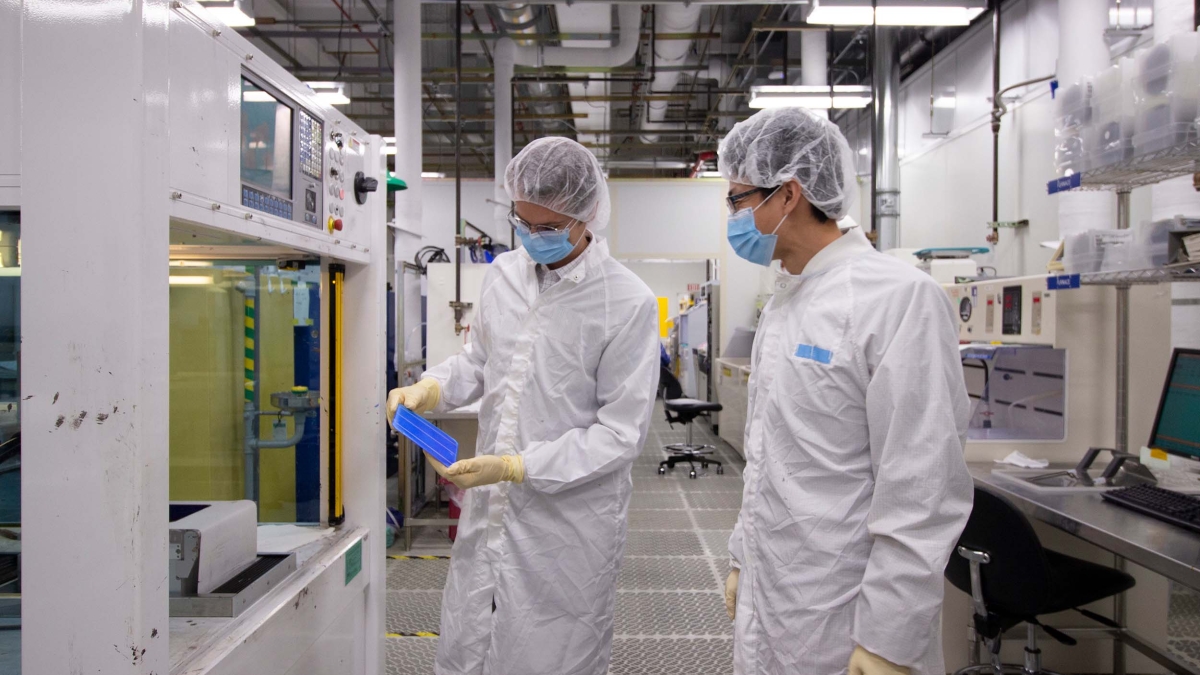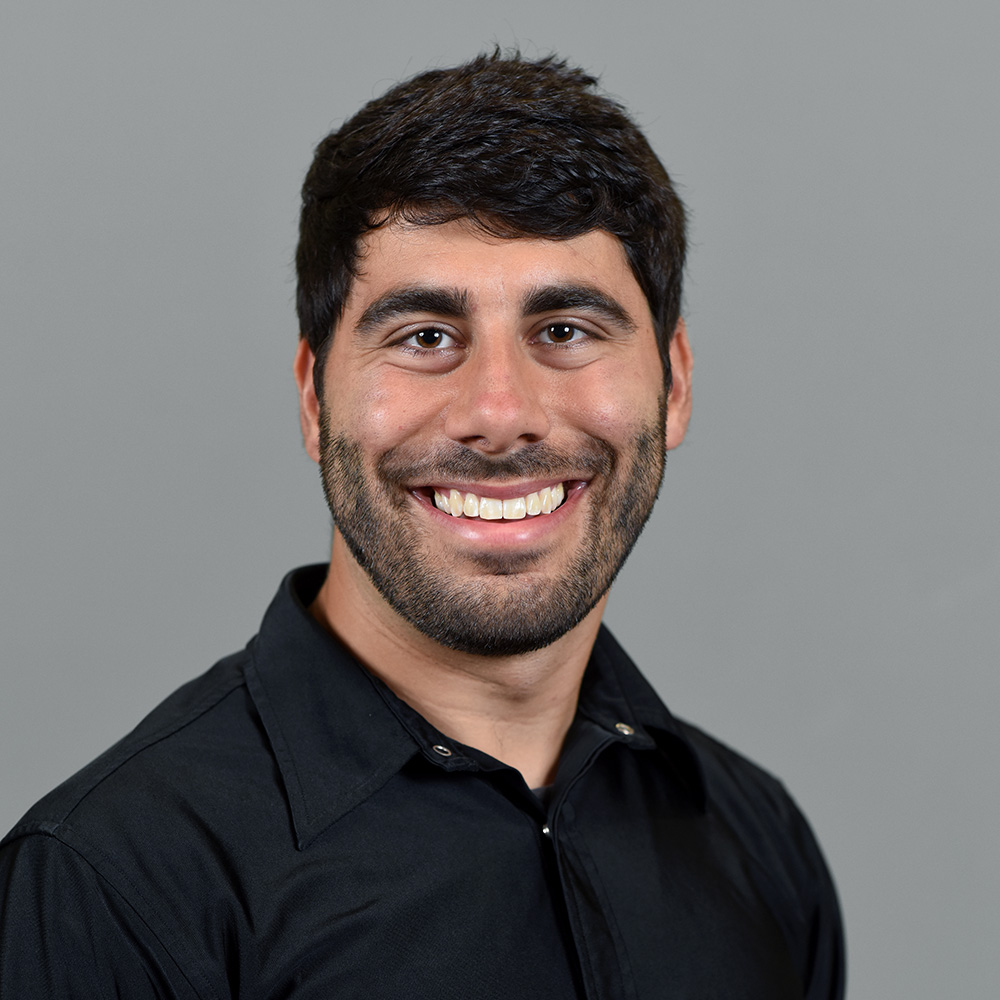ASU researchers TEAMUP to advance solar capabilities

Researchers in Arizona State University’s MacroTechnology Works facility examine a solar cell. Photo by Erika Gronek/ASU
As climate change becomes an increasingly pressing problem worldwide, the race to develop sustainable power-generation technology is ever more crucial. A new consortium of academic and industry partners, Tandems for Efficient and Advanced Modules using Ultrastable Perovskites, or TEAMUP, looks to help mitigate climate change by making a new generation of solar technology commercially viable.
The three-year TEAMUP collaboration, which is planned to start in fall 2023, is supported by $9 million in funding from the U.S. Department of Energy. TEAMUP seeks to maximize the performance and reliability of tandem solar panels for consumer use.
Tandem refers to solar panels that are made from a combination of two or more cells optimized to absorb different sections of the electromagnetic spectrum, or simply put, colors of light.
Halide perovskites are a family of materials that have shown tremendous potential for high performance and low production costs in solar cells. The term “perovskite” comes from the name for the materials’ crystal structure. Perovskites and silicon absorb different colors of sunlight, resulting in a greater combined efficiency than panels made from either material alone.
Ultimately, the consortium hopes to use this emerging technology to put the U.S. at the forefront of solar technology manufacturing. The project aligns with Arizona’s New Economy Initiative, which is positioning the state as a hub for advanced jobs in engineering, technology and advanced manufacturing.
The consortium’s efforts also directly relate to the goals of ASU’s Advanced Materials, Processes, and Energy Devices, or AMPED, Science and Technology Center (STC), which has photovoltaic, or solar, technology as one of its primary research thrusts.
An academic collaboration for solar innovation
Academic and government partners in the consortium include the Ira A. Fulton Schools of Engineering at Arizona State University; the University of Colorado Boulder; the University of California, Merced; Northwestern University; and the National Renewable Energy Laboratory.
Assistant Professor Nick Rolston
ASU’s involvement includes research groups run by Assistant Professor Nick Rolston and Associate Professors Mariana Bertoni and Zachary Holman, all electrical engineering faculty members in the School of Electrical, Computer and Energy Engineering, part of the Fulton Schools.
Work at the University of Colorado Boulder, which leads the academic research efforts of the partnership, is run by Michael McGehee, a professor and James and Catherine Patten Chair in Chemical Engineering. Perovskite materials for solar panels are McGehee’s area of expertise.
“Mike McGehee was almost like a co-advisor to me when I was doing my doctoral degree at Stanford,” Rolston said. “I worked with several of his students in his lab quite frequently.”
Rolston estimates that although the University of Colorado leads the consortium’s academic investigations, ASU will significantly contribute to the research. Each ASU research group will play a different and complementary role: Rolston’s group will examine mechanical macro-level damage limits of the tandem silicon and perovskite panels; Bertoni’s group will focus on conducting X-ray characterization of micro-level structural strains during aging; and Holman’s group will examine how to use the panels’ optoelectronic properties to generate as much electricity as possible.
Delivering entrepreneurial impact
Beyond Silicon, which specializes in tandem solar panel technology and was founded by Holman and ASU electrical engineering Assistant Research Professor Zhengshan Yu, is involved in the industry efforts to make the technology viable for commercial and consumer use. Swift Solar and Tandem PV, both tandem solar technology companies based in the San Francisco Bay area and started by McGehee’s former students, round out the industry consortium members.
Under Holman’s guidance while a graduate student at ASU, Yu worked with McGehee to develop a tandem solar panel that set a power generation efficiency record. Now, as CEO of Beyond Silicon, Yu and the other industry collaborators will focus on making tandem solar technology commercially viable by scaling it up from the small sizes used in labs.
“The U.S. has lost its photovoltaic manufacturing prominence to countries in Asia,” Yu said. “Perovskite and silicon tandem technology is the next opportunity to return the U.S. to a leading position of photovoltaic manufacturing. This technology will make solar technology more affordable to decarbonize the grid and be a key energy generation technology for a sustainable future.”
The AMPED STC aids Yu through its Entrepreneurial Fellowship Program, which provides entrepreneurship funding to private sector projects that stimulate research and development in Arizona.
Yu believes that the TEAMUP public-private partnership is a great boost to help industry commercialize tandem solar technology.
“As scientific challenges still remain to make tandem panels commercially viable, a consortium of industry partners plus academic institutions is the best way to achieve that goal,” he said.
Developing solar solutions
The ASU research groups will also provide opportunities to students from the undergraduate to doctoral levels to conduct hands-on research. Rolston said students in his group will take part in everything from producing panels to conducting durability testing and analysis.
“The techniques that my research group use basically involve breaking things apart,” Rolston said. “We use tensile testers that can rip apart the materials to understand how much energy that takes and what the weak point is.”
His group is looking to add more students to aid in the work, especially those in undergraduate and master’s degree programs. The work can fulfill project requirements for the Fulton Undergraduate Research Initiative and Master’s Opportunity for Research in Engineering programs, theses for ASU’s Barrett, The Honors College, master’s degree programs and more.
Bertoni expects that the project’s findings will help to derisk this new technology, attracting businesses to invest in Arizona.
“I think that if we solve some of the reliability issues and show a path to manufacturability and long-term performance, these perovskite technologies will seed a lot of new ideas and businesses,” she said.
Rolston hopes those new businesses could find a home in Arizona, explaining that microelectronics manufacturing infrastructure is similar to that used for solar technology.
“Arizona has such strengths in semiconductors from companies like TSMC and Intel, along with expertise from the workforce,” he said. “I think Arizona would be the perfect place to produce solar panels, which would bring a lot of jobs to the state.”
Students interested in conducting research with Rolston’s group can contact him at nicholas.rolston@asu.edu.
More Science and technology

Science meets play: ASU researcher makes developmental science hands-on for families
On a Friday morning at the Edna Vihel Arts Center in Tempe, toddlers dip paint brushes into bright colors, decorating paper…

ASU water polo player defends the goal — and our data
Marie Rudasics is the last line of defense.Six players advance across the pool with a single objective in mind: making sure that…

Diagnosing data corruption
You are in your doctor’s office for your annual physical and you notice the change. This year, your doctor no longer has your…


